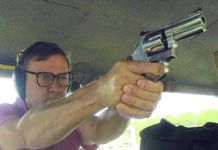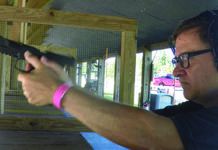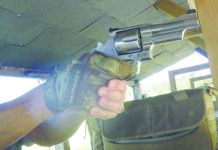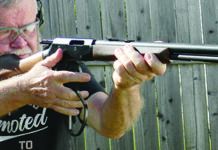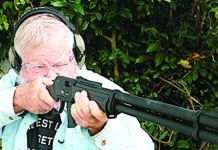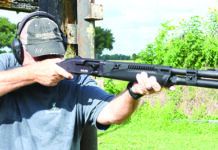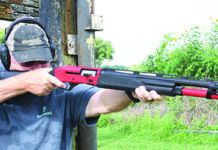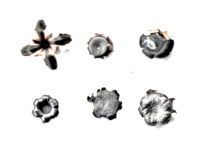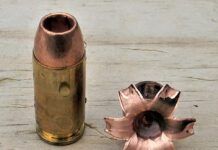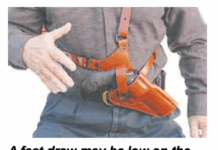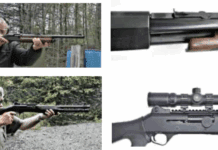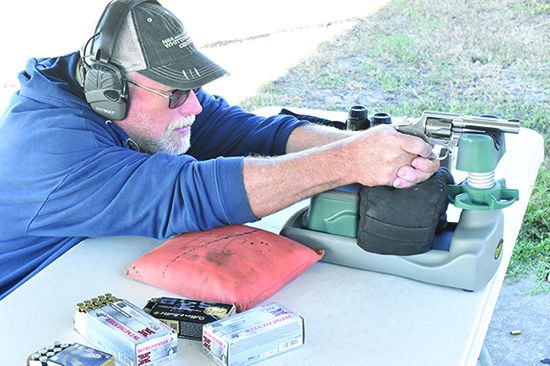Some shooters need one handgun to do everything — some self defense, some target plinking, a bit of small-animal hunting. We think that a mid-size, mid-weight, mid-price 357 Magnum revolver does a great job of filling those and other needs.
To that end, we are testing here three 357 Magnum revolvers with 4-inch barrels for overall utility. The first is the well-proven Ruger SP101 05771, $747. Made of stainless steel with a full-length underlug and a five-shot cylinder, it could be a great revolver to tote around in the woods. The second is the new Colt Viper SP4WRR, $970. Also in stainless steel with a 4.25-inch barrel, fixed sights, and nice walnut grips, the Viper sports a six-shot cylinder. Our last test piece is a Taurus Model 66 2-660049, $490. Available in blued or stainless steel, the Model 66 brings a heavy barrel, seven-round capacity, and great sights along with a very reasonable price.
To see what these wheelguns could do, we fired two 38 Special loads, Federal’s 110-grain Personal Defense rounds and Sellier & Bellot 148-grain wadcutters. To assess the top end of their power range, we also fired a 357 Magnum load, Winchester’s 158-grain jacketed hollow points. Here’s how the three revolvers performed.
Colt Viper SP4WRR 357 Magnum
$970
Gun Tests grade: B
This is the third Colt revolver that the Houston group has reviewed recently. All three have provided excellent triggers and very smooth actions. Colt must be using the same magic pixie dust from their Pythons on these less expensive Vipers.
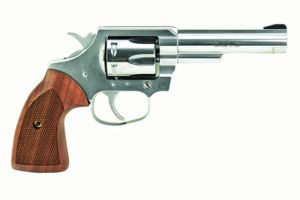
| Action Type | Revolver |
|---|---|
| Overall Length | 9.25 in. |
| Overall Height | 5.0 in. |
| Maximum Width | 1.4 in. |
| Weight Unloaded | 1.8 lbs. |
| Weight Loaded | 2.0 lbs. |
| Barrel Length | 4.2 in. |
| Barrel Material | Stainless steel |
| Frame Material | Stainless steel |
| Cylinder Material | Stainless steel |
| Grip Front Strap Height | 2.2 in. |
| Grip Back Strap Height | 4.0 in. |
| Grip Thickness (Maximum) | 1.25 in. |
| Grip Circumference | 5.4 in. |
| Capacity | 6 |
| Rear Sight | Fixed notch |
| Front Sight | Replaceable black ramp |
| Sight Radius | 5.75 in. |
| Trigger Pull Weight (Double Action) | 7.65 lbs. |
| Trigger Pull Weight (Single Action) | 2.8 lbs. |
| Trigger Span | 3.0 in. |
| Safety | Transfer bar |
| Warranty | 1-year non-transferrable |
| Telephone | (800) 241-2485 |
| Website | Colt.com |
| Made In | U.S. |
The Python — the absolute Cadillac of the Colt handgun line — was discontinued in 2005 and the shooting world shed a tear. Tooling and fixtures were worn out. The polishing and fitting the original Pythons required had become prohibitively expensive. We understood why Colt executives made the decision they did, but it was still sad.
It turns out that Colt never quit on the Python design, though. CNC programming now allows machines to hold tolerances previously thought to be impossible. Colt took the new technology and announced the 2nd Generation Python in 2020. Is it the same handgun? Nope. In some ways, it is better. The new version is stronger. We mentioned the improved machining capabilities which, in turn, require less hand fitting. All this means is that the Colt can still feel great in the hand and still shoot very well indeed, while it doesn’t have to cost as much. As we have reviewed additional Colt revolvers for you, it seems to us that Colt engineers have taken many of the lessons they learned in their redesign of the Python and applied some of that magic to other, even less expensive, Colt revolvers, such as this gun.
Our Viper sample sports a 4.25-inch barrel and polished stainless-steel construction. The barrel is round with a small rib on top. The Viper provides a short underlug sufficient to cover just the ejector rod. With the frame somewhat larger than that of the Ruger SP101 and less barrel mass out front, the Viper is more heavily weighted toward the rear of the gun. We thought the rearward-skewed center of gravity and a couple of other items we’ll touch on in a moment may have served to make the Viper recoil livelier than our other two revolvers.
The action was the smoothest in this test. The hammer cocked easily. The trigger was, once again, flat-faced with nicely-rounded edges. Required trigger compression was only 7.6 pounds double action and 2.8 pounds single action. Colt triggers historically tended to stack, which means the required pressure increased, or stacked, as the trigger was compressed to the rear. Not on this Viper. The trigger stroke was smooth and crisp all the way to the rear.
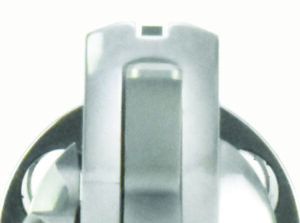
Colt cylinder latches operate by being pulled to the rear. This latch moved easily and locked up smoothly when the cylinder was closed. The six-round cylinder would spin smoothly on the ejector rod, which was also easy to operate. The action feels like skilled pistolsmiths were at work hand-tuning this revolver.
Several more things bear comment. The sights consist of a groove in the top strap and a fixed front blade. The front sight is held in by a set screw, so you should be able to substitute your favorite front blade as desired. The grips are a lightly grained light-brown walnut. They leave the backstrap of the revolver exposed and frame it nicely on the sides, thus allowing additional width to help mitigate recoil. The grip panels were of medium length, proving to be more than two fingers and less than three fingers long for us. We would like to see them lengthened a bit. The curve at the rear of the trigger guard was further to the rear on the Viper than on the Ruger or the Taurus. The result was the middle finger on our strong hand taking a bit of a beating under recoil. We also found the bottom outside edges of the trigger to be somewhat sharp, further abrading the index finger of our support hands during the extended shooting sessions. The edges are easy to smooth out on a stainless-steel handgun, but we would love to see Colt address this at the plant. The net effect of a light front end resulted in lively recoil, while holding onto the Viper’s grip frame was a bit of a challenge for us when using magnum loads. We also realize that there are differently-sized hands for which the Colt Viper might be absolutely perfect. The 38 Special loads did not cause any issues at all.
Our Team Said: This is the third Colt revolver that the Houston test team has reviewed recently. All three have provided excellent triggers and very smooth actions. Colt must be using the same smart production standards from their Pythons on these less-expensive Vipers.
The Colt Viper averaged less than 1.7 inches for all the groups combined. It showed a preference for the Sellier & Bellot 148-grain wadcutter load, with a best group of 0.76 inch. It did well in the speed drills, placing second to the larger Taurus Model 66. The action was the smoothest of the three revolvers tested, in our opinion. It also consistently showed the highest velocities of the three, meaning more energy downrange.
| 38 SPECIAL/357 MAGNUM RANGE DATA | |||
|---|---|---|---|
| Federal Personal Defense 38 Special 110-grain JHP | Colt Viper | Ruger SP101 | Taurus Model 66 |
| Average Velocity | 1009 fps | 912 fps | 929 fps |
| Muzzle Energy | 249 ft.-lbs. | 203 ft.-lbs. | 211 ft.-lbs. |
| Average Group | 1.80 in. | 1.27 in. | 0.93 in. |
| Best Group | 1.99 in. | 1.77 in. | 1.01 in. |
| Sellier & Bellot 38 Special 148-grain WC | Colt Viper | Ruger SP101 | Taurus Model 66 |
| Average Velocity | 684 fps | 617 fps | 644 fps |
| Muzzle Energy | 154 ft.-lbs. | 125 ft.-lbs. | 136 ft.-lbs. |
| Average Group | 0.76 in. | 1.72 in. | 1.28 in. |
| Best Group | 1.43 in. | 2.08 in. | 1.34 in. |
| Winchester Super-X 357 Magnum 158-grain JSP | Colt Viper | Ruger SP101 | Taurus Model 66 |
| Average Velocity | 1211 fps | 1137 fps | 1182 fps |
| Muzzle Energy | 514 ft.-lbs. | 454 ft.-lbs. | 490 ft lbs |
| Average Group | 1.51 in. | 1.67 in. | 1.28 in. |
| Best Group | 1.66 in. | 1.85 in. | 1.42 in. |
We tested at American Shooting Centers (AmericanShootingCenter.com) in Houston. We fired multiple five-shot groups at 15 yards. These revolvers were well-sandbagged in a Caldwell Pistolero Shooting Rest from Midway USA, No. 517357, $28, assisted by a Mini DRC Fortune Cookie from Wiebad.com (MINIFC, $75). We also fired additional one- and three-shot strings offhand to test for ease of handling and accuracy at full speed. We used a Garmin Xero C1 Pro ($599) to collect velocities. We used a CED7000 shot timer to collect elapsed times.
| DRILL NO. 1 DATA | |
|---|---|
| Pistol | Single Shot Average Time |
| Colt Viper | 0.85 |
| Ruger SP101 | 0.9 |
| Taurus Model 66 | 0.72 |
Process: Fire one shot from low ready at 3-by-5-inch card placed at 15 yards. Times in seconds are averages for five repetitions.
| DRILL NO. 2 DATA | |||
|---|---|---|---|
| Pistol | 1st Shot | Split Average | Total Time |
| Colt Viper | 0.85 | 0.294 | 1.44 |
| Ruger SP101 | 0.9 | 0.35 | 1.64 |
| Taurus Model 66 | 0.783 | 0.288 | 1.36 |
Process: Fire three shots from low ready at 3-by-5-inch card placed at 8 yards using 38 Special ammo. Times in seconds are averages for three repetitions.
| DRILL NO. 3 DATA | |||
|---|---|---|---|
| Pistol | 1st Shot | Split Average | Total Time |
| Colt Viper | 0.823 | 0.532 | 1.887 |
| Ruger SP101 | 0.87 | 0.508 | 1.887 |
| Taurus Model 66 | 0.753 | 0.318 | 1.118 |
Process: Fire three shots from low ready at 3-by-5-inch card placed at 8 yards using 357 Magnum ammo. Times in seconds are averages for three repetitions.
Written and photographed by Joe Woolley, using evaluations from Gun Tests Team members. GT




